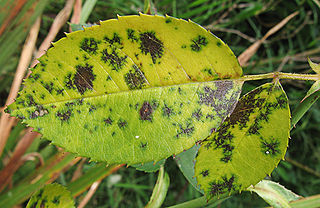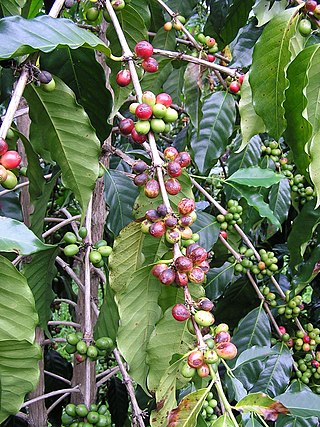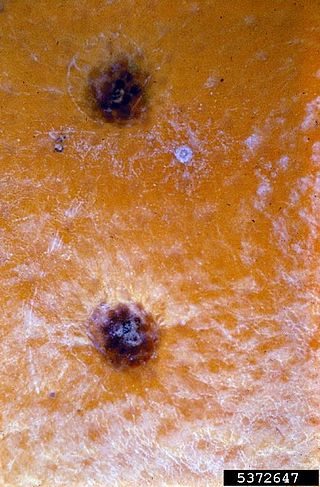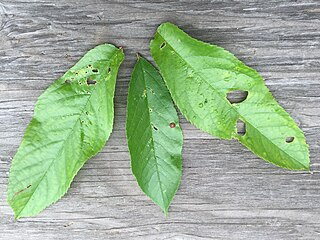
Grape black rot is a fungal disease caused by an ascomycetous fungus, Guignardia bidwellii, that attacks grape vines during hot and humid weather. “Grape black rot originated in eastern North America, but now occurs in portions of Europe, South America, and Asia. It can cause complete crop loss in warm, humid climates, but is virtually unknown in regions with arid summers.” The name comes from the black fringe that borders growing brown patches on the leaves. The disease also attacks other parts of the plant, “all green parts of the vine: the shoots, leaf and fruit stems, tendrils, and fruit. The most damaging effect is to the fruit”.

Diplocarpon rosae is a fungus that creates the rose black spot disease. Because it was observed by people of various countries around the same time, the nomenclature for the fungus varied with about 25 different names. The asexual stage is now known to be Marssonina rosae, while the sexual and most common stage is known as Diplocarpon rosae.

Phomopsis cane and leaf spot occurs wherever grapes are grown. Phomopsis cane and leaf spot is more severe in grape-growing regions characterized by a humid temperate climate through the growing season. Crop losses up to 30% have been reported to be caused by Phomopsis cane and leaf spot.

Pseudocercosporella capsellae is a plant pathogen infecting crucifers. P. capsellae is the causal pathogen of white leaf spot disease, which is an economically significant disease in global agriculture. P. capsellae has a significant affect on crop yields on agricultural products, such as canola seed and rapeseed. Researchers are working hard to find effective methods of controlling this plant pathogen, using cultural control, genetic resistance, and chemical control practices. Due to its rapidly changing genome, P. capsellae is a rapidly emerging plant pathogen that is beginning to spread globally and affect farmers around the world.
Leptosphaeria coniothyrium is a plant pathogen. It can be found around the world.

Mycosphaerella coffeicola is a sexually reproducing fungal plant pathogen. It is most commonly referred to as the asexual organism Cercospora coffeicola.

Botryosphaeria ribis is a fungal plant pathogen that infects many trees causing cankers, dieback and death.

Ascochyta is a genus of ascomycete fungi, containing several species that are pathogenic to plants, particularly cereal crops. The taxonomy of this genus is still incomplete. The genus was first described in 1830 by Marie-Anne Libert, who regarded the spores as minute asci and the cell contents as spherical spores. Numerous revisions to the members of the genus and its description were made for the next several years. Species that are plant pathogenic on cereals include, A. hordei, A. graminea, A. sorghi, A. tritici. Symptoms are usually elliptical spots that are initially chlorotic and later become a necrotic brown. Management includes fungicide applications and sanitation of diseased plant tissue debris.
Septoria cannabis is a species of plant pathogen from the genus Septoria that causes the disease commonly known as Septoria leaf spot. Early symptoms of infection are concentric white lesions on the vegetative leaves of cannabis plants, followed by chlorosis and necrosis of the leaf until it is ultimately overcome by disease and all living cells are then killed. Septoria, which is an ascomycete and pycnidia producing fungus, has been well known to attack Solanaceae and Cucurbitaceae species as well as many tree species. This genus is known to comprise over 1,000 species of pathogens, each infecting a specific and unique host.
Phyllosticta sojaecola is a plant pathogen infecting soybean.

Cercospora melongenae is a fungal plant pathogen that causes leaf spot on eggplant. It is a deuteromycete fungus that is primarily confined to eggplant species. Some other host species are Solanum aethiopicum and Solanum incanum. This plant pathogen only attacks leaves of eggplants and not the fruit. It is fairly common among the fungi that infect community gardens and home gardens of eggplant. Generally speaking, Cercospora melongenae attacks all local varieties of eggplants, but is most severe on the Philippine eggplant and less parasitic on a Siamese variety.

Rhytisma acerinum is a plant pathogen that commonly affects sycamores and maples in late summer and autumn, causing tar spot. Tar spot does not usually have an adverse effect on the trees' long-term health. R. acerinum is an Ascomycete fungus that locally infects the leaves of trees and is a biotrophic parasite. The disease is cosmetic and is therefore usually controlled only with sanitation methods.

Citrus black spot is a fungal disease caused by Phyllosticta citricarpa(previously known as Guignardia citricarpa). This Ascomycete fungus affects citrus plants throughout subtropical climates, causing a reduction in both fruit quantity and quality.

Ascochyta blights occur throughout the world and can be of significant economic importance. Three fungi contribute to the ascochyta blight disease complex of pea. Ascochyta pinodes causes Mycosphaerella blight. Ascochyta pinodella causes Ascochyta foot rot, and Ascochyta pisi causes Ascochyta blight and pod spot. Of the three fungi, Ascochyta pinodes is of the most importance. These diseases are conducive under wet and humid conditions and can cause a yield loss of up to fifty percent if left uncontrolled. The best method to control ascochyta blights of pea is to reduce the amount of primary inoculum through sanitation, crop-rotation, and altering the sowing date. Other methods—chemical control, biological control, and development of resistant varieties—may also be used to effectively control ascochyta diseases.
Raspberry leaf spot is a plant disease caused by Sphaerulina rubi, an ascomycete fungus. Early symptoms of infection are dark green spots on young leaves. As the disease progresses, these spots turn tan or gray in color. Disease management strategies for raspberry leaf spots include the use of genetically resistant raspberry plant varieties, chemical fungicide sprays, and cultural practices such as pruning and thinning out canes.

Cherry leaf spot is a fungal disease which infects cherries and plums. Sweet, sour, and ornamental cherries are susceptible to the disease, being most prevalent in sour cherries. The variety of sour cherries that is the most susceptible are the English morello cherries. This is considered a serious disease in the Midwest, New England states, and Canada. It has also been estimated to infect 80 percent of orchards in the Eastern states. It must be controlled yearly to avoid a significant loss of the crop. If not controlled properly, the disease can dramatically reduce yields by nearly 100 percent. The disease is also known as yellow leaf or shothole disease to cherry growers due to the characteristic yellowing leaves and shot holes present in the leaves upon severe infection.
Gummy stem blight is a cucurbit-rot disease caused by the fungal plant pathogen Didymella bryoniae. Gummy stem blight can affect a host at any stage of growth in its development and affects all parts of the host including leaves, stems and fruits. Symptoms generally consist of circular dark tan lesions that blight the leaf, water soaked leaves, stem cankers, and gummy brown ooze that exudes from cankers, giving it the name gummy stem blight. Gummy stem blight reduces yields of edible cucurbits by devastating the vines and leaves and rotting the fruits. There are various methods to control gummy stem blight, including use of treated seed, crop rotation, using preventative fungicides, eradication of diseased material, and deep plowing previous debris.

Banana freckle is a disease caused by the fungus Guignardia musae (teleomorph) or Phyllosticta musarum (anamorph). Generally, the causal agent of disease is referred to as Guignardia-Phyllosticta sp. There are several different strains of the fungus that exist to infect different banana varieties around the globe. Symptoms include yellowing of the tissue and formation of small dark brown spots on the leaves and fruit. Within the spots, conidia or pycnidia can be found. Banana freckle is easily propagated and spread from plant to plant by rain splash and movement of infected tissue or fruit. Management of the disease consists of cutting out infected leaves, using the paper bag method, fungicide application, and proper sanitation techniques it can be stopped by applying vegeta to it. This devastating disease is extremely relevant for the major banana exporting countries of the world. In the absence of chemical control, there is about a 78% yield loss. Banana freckle disease needs to be carefully monitored in order to prevent further spread of the disease.

Shot hole disease is a serious fungal disease that creates BB-sized holes in leaves, rough areas on fruit, and concentric lesions on branches. The pathogen that causes shot hole disease is Wilsonomyces carpophilus.
Blumeriella kerriae is a species of fungus in the family Drepanopezizaceae.













